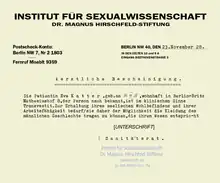Transvestite pass
A transvestite pass (German: Transvestitenschein) was a doctor's note recognized by the governments of Imperial Germany and the Weimar Republic – under the support of sexologist Magnus Hirschfeld – identifying a person as a transvestite. Transvestite at this time referred to all individuals whose gender identity or preferred clothing was discordant to that associated with their assigned sex, and so included both crossdressing and transgender people.[3]

.jpg.webp)
In either 1908 or 1909, the first known pass was issued to a female-to-male transvestite. This was achieved with the expert opinion of Hirschfeld as well as Karl Abraham.[4] From then up until 1933, "perhaps dozens" of such passes were granted by the German police.[5][4] Mainly given to middle-class, heterosexual, male-to-female transvestites to avoid associations with gay and lesbian culture in Weimar Germany, the certificate said that the individual in question was allowed to wear clothing which corresponded to their gender identity.[3]
In 1922, guidance issued by the police headquarters of Berlin regarding this policy stated:
Apart from male prostitution, transvestism in general has no criminal significance. The widespread public opinion that the disguised individuals are generally criminals in disguise (pickpockets, spies, pimps, etc.) is obsolete. Regarding the male transvestites, recent experience shows that even the formerly taken-for-granted view that men in women's clothing are all homosexuals is no longer tenable. [...] Based on this insight emerges a duty of gentle treatment [schonenden Behandlung] of transvestites, as long as they are not engaged in male prostitution.[4]
After the Nazis came to power, most passes were revoked or German police refused to recognize them.[6]
See also
- Transgender rights in Germany (since 1980)
- First homosexual movement
References
- Jander, Thomas (23 July 2019). "What's that for? A Licence to Be (Different) – Deutsches Historisches Museum: Blog". Retrieved 5 February 2021.
- Taylor, Michael T.; Timm, Annette; Herrn, Rainer (30 October 2017). Not Straight from Germany: Sexual Publics and Sexual Citizenship Since Magnus Hirschfeld. University of Michigan Press. p. 44. ISBN 978-0-472-13035-1. Retrieved 5 February 2021.
- Gershon, Livia (18 November 2018). "Gender Identity in Weimar Germany". JSTOR Daily. Retrieved 19 July 2019.
- Sutton, Katie (2012). ""We Too Deserve a Place in the Sun": The Politics of Transvestite Identity in Weimar Germany". German Studies Review. 35 (2): 335–354. ISSN 0149-7952. JSTOR 23269669.
- Frost, Natasha (2 November 2017). "The Early 20th-Century ID Cards That Kept Trans People Safe From Harassment". Atlas Obscura. Retrieved 19 July 2019.
- Marhoefer, Laurie (2023-06-06). "Historians are learning more about how the Nazis targeted trans people". The Conversation. Retrieved 2023-06-19.
External links
- "A German baron now a countess by court decree". Asheville Citizen-Times. 11 August 1912. p. 14.